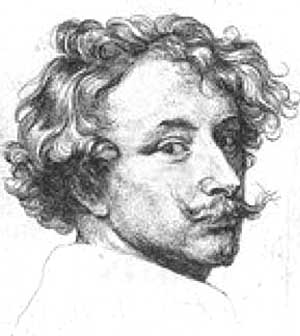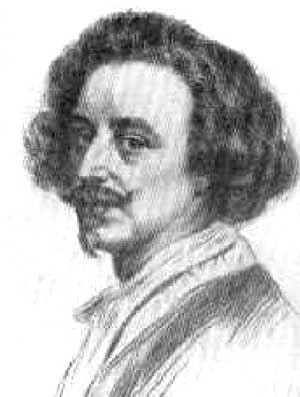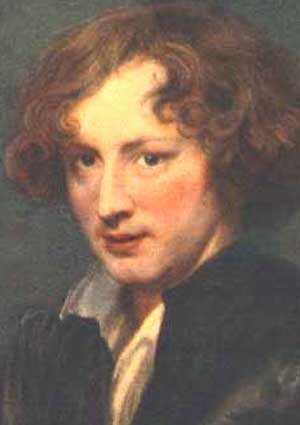Copyright Michael D. Robbins 2005
Astro-Rayological Interpretation & Charts
Quotes
Biography
Images and Physiognomic Interpretation
Sir Anthony (Antoon) van Dyck (*March 22, 1599 - December 9, 1641) was a Flemish painter — mainly of portraits — who became the leading court painter in England. He was also a master of etching.
Van Dyck was born in Antwerp and became an independent painter in 1615. In his younger years, he was the chief assistant of Peter Paul Rubens. In 1620, he came to England for the first time but did not succeed in getting presented to King James I. After four months he returned to Flanders. He then went to Italy where he remained for 6 years studying the Italian masters and laying the foundations of his career as a successful portraitist. In 1627, he went back to Antwerp where for some years he painted a host of masterpieces. His reputation reached the ears of Charles I of England who recalled him. In 1632, Van Dyck again arrived in London. His success in England was rapid. He painted portraits of King Charles, Queen Henrietta, the king's children, and countless personages at court in addition to iimages of himself and his mistress, Margaret Lemon. In the latter part of his life he only gave finishing touches to the portraits which were for the most part painted by his pupils after his own designs. He was charming to his patrons, which added to his ability to obtain commissions.
In July 1632, he was knighted, and in 1633 elected painter to the king. He received a considerable pension and married the daughter of Lord Ruthven. In 1634, he took a short journey to Antwerp, and in 1641, another one to France.
Anthony van Dyck died in 1641 in London, and was buried in St. Paul's Cathedral.
Van Dyck had a great influence on English portrait painting. Therefore, some scholars call him the founder of the English school of painting.
Van Dyck was also known for painting portraits of people having short, pointed beards, and that's why this particular kind of beard was named after him a vandyke. During the reign of George III, a generic "Cavalier" fancy-dress costume called a 'Van Dyke' was popular; Gainsborough's 'Blue Boy' is wearing such a 'Van Dyke' outfit. The oil paint pigment van Dyck brown is named after him
Anthony Van Dyck was born in Antwerp on the 22 March 1599. Artistically
precocious, he was apprenticed to the minor figure painter, Hendrik van
Balen in the Guild of St.\ Luke, Antwerp, as early as 1609. By 1615-16 he
was already working independently and, in 1618, he was admitted to the
Guild as a master painter. Contrary to popular belief, he was never a
pupil of Rubens, though, during the period 1618--21, he worked as
Rubens's principal assistant, often executing finished pictures after
the master's designs. Not surprisingly, the influence of Rubans is
especially marked in Van Dyck's early works; but. throughout his short
career he was often to follow in the elder artist's footsteps - and to
some extent in his shadow.Van Dyck was briefly in England in 1620, apparently at the invitation
of James I. By 1621, however, he was back in Antwerp; and, in the same
year, he left for six years in Italy. During this period he travelled
widely, visiting Rome, Florence, Venice, and Palermo; but his most
fruitful Italian years were spent in Genoa (1623--27), where he painted a
splendid series of portraits of the local aristocracy. These pictures -
many of which may now be seen in the National Gallery, Washington - are
arguably his greatest achievements as a portraitist and are certainly
among the noblest examples of their genre.Van Dyck returned to Antwerp in 1627 and re-established his studio,
presumably in the hope of vying with Rubens for some of the prize
commissions from the court at Brussels. By 1629 he was already being
patronised by Charles I; and, three years later, in 1632, he moved to
London, where he was to spend most of the remainder of his life. He was
immediately knighted and made the king's `principalle paynter' and,
thereafter, devoted the rest of his career primarily to painting the
Royal family and members of the Stuart court. He died at Blackfriars on
9 December 1641 and was buried in old St.\ Paul's Cathedral.Van Dyck is rightly remembered as a supreme master of the formal
portrait but, in addition to this. he was also accomplished and
prolific both as a religious and a historical painter; and, at the end
of his life, he produced a small series of astonishing landscape
water-colours which in many ways prefigure later English achievements in
this field. Although it is impossible to be certain, Van Dyck may have
been drawn to portraiture only after realising that his talents as an
history painter were insufficient to compete with those of Rubens.
Certainly, from the number of commissions for history paintings he
repeatedly sought (and often did not get), it would appear that it was
in this field that he wished to make his mark as an artist. But, in
the event, Van Dyck's loss has been posterity's gain; for the
magnificent series of portraits he produced in the mere two decades of
his short career were to open up a new chapter in the history of Western
art. Although his portrait cycle evolved considerably, it is always
marked by a fluent and slightly nervous virtuosity of handling, a
remarkable sensitivity to nuances of light and texture, a superb
inventiveness, and an unfailing ability to inhabit the social world of
his sitters. His characterizations are invariably urbane, sympathetic,
and acutely observed, and, on occasion - e.g. when he is painting close
friends or fellow-artists - they can also be deeply moving. If his
genius was less robust and all-embracing than that of Rubens, it often
excels the elder master's in grace and elegance both of design and
execution. In addition to these qualities, his importance for later
English art cannot be overestimated. During the brief period of his
residence in England he single-handedly brought this country into the
forefront of European taste and achievements in the visual after his
death, he remained the most important model for later British masters of
the formal portrait. Reynolds and Gainsborough were especially
indebted to him, as the latter acknowledged on his death-bed, when he
observed to Reynolds: `We shall all go to heaven, and Van Dyck is of the
company'.Anthony van Dyck (Antonis van Dijck) is one of the greatest Flemish painters. He was born on the 23rd of March, 1599 in Antwerp, 7th child in the family of a well-to-do silk merchant Frans van Dyck. After the early death of his mother he, at the age of 10, was sent to be trained by painter Hendrick van Balen in his workshop. In 1615, he already had his own workshop and an apprentice. In 1618, he was accepted as a full member of the Lucas Guild of painters.
In 1618-1620, Van Dyck was working with Rubens as his pupil and assistant. He took part in the painting of the Jesuit Church in Antwerp. Also he painted such religious works as Samson and Delilah (1620), The Crowning with Thorns (1620), Judas' Kiss (1618-1620), St. Martin Dividing His Cloak (1620-1621) and portraits: Frans Snyders (1618), Margareta de Vos (1618), Family Portrait (1621) and several known self-portraits. Although Van Dyck was with Rubens little more than two years, the older master's style affected his own indelibly.
By his twenty-first year Van Dyck was already ripe for independence. His pride and ambition made it hard for him to stand in Rubens' shadow in Antwerp. He therefore accepted the invitation from Earl of Arundel to London, where he stayed several months. In England he painted Thomas Howard, 2nd Earl of Arundel (1620-1621) and other pictures. Also he was able to study the numerous works of the masters of Italian Renaissance, which were in the collections of the Earl of Arundel and the Duke of Buckingham. This led him to follow in the footsteps of his teachers Van Balen and Rubens and finish his education in Italy.
Van Dyck left London in February, 1621 and after staying 8 months in Antwerp, he arrived in Italy by the end of 1621. He spent 6 years in Italy, staying mostly in Genoa and traveling to Rome, Venice, Turin and Palermo, studying and copying the Venetian masters - Tintoretto, Veronese, and particularly Titian, whose works influenced him greatly. He earned his livelihood by creating portraits especially of the Genoese aristocracy. The most notable portraits were George Gage, Looking at a Statuette (1623), Cardinal Bentivolo (1622-1623), Lucas van Uffeln (1622), Elena Grimaldi, Marchesa Cattaneo (1623), Paola Adorno, Marchesa Brinole-Sale with Her Son (1626), Giovanni Vincenzo Imperiale (1626). Also he was commissioned to paint some pictures for the Church Oratorio del Rosario depicting St. Rosalia, the patroness saint of Palermo. Other well-known religious picture of this period are Susanna and the Elders (1621-1622), The Four Ages of Man (1626), The Tribute Money (1620s).
In 1627, Van Dyck returned to Antwerp, where he was given a triumphal welcome. He received many commissions for churches and became a court painter to the Archduchess Isabella in 1630. He created an astonishing amount of portraits during his stay in Antwerp in 1627-1632, the best of them are Portrait of Maria Louisa de Tassis (c.1630), Philippe Le Roy (1630), Marie de Raet, Wife of Philippe Le Roy (1631), Prince Rupert von der Pfalz (1631-1632). He also undertook a bigger project Iconography, for which he created the engravings of the famous people of the time: monarchs, commanders, philosophers, artists, collectors. It was published in 1628-1641.
In 1632, Charles I invited Van Dyck to England to be a court painter. He was knighted, rewarded with the generous annuity of £200 and lavished with gifts. Sir Anthony van Dyck was crucial to Charles I: his portraits were designed to support the King in his claim to be absolute monarch. Other artists painted Charles, too, but it is Van Dyck's image of this melancholic, doomed King that is remembered in history. Van Dyck painted 37 pictures of Charles I and 35 of his Queen Henrietta Maria. The best of them are Equestrian Portrait of Charles I, King of England with Seignior de St. Antoine (1633), Queen Henrietta Maria with Sir Jeffrey Hudson (1633), Charles I, King of England, at the Hunt (1635) Charles I, King of England (1636), Charles I, King of England, from Three Angles (1636), Children of Charles I (1635), Equestrian Portrait of Charles I, King of England (1638). Van Dyck become a celebrated portraitist of the English court and aristocracy. In less that 10 years he created over 350 pictures, including royal portraits. His best portraits are Philip, Lord Wharton (1632), George Villiers, 2nd Duke of Buckingham and His Brother Lord Francis Villiers (1635), Thomas Howard, 2nd Earl of Arundel and Surrey with His Grandson Lord Maltravers (1635), James Stuart, Duke of Lennox and Richmond (1637), Lord John Stuart and His Brother Lord Bernard Stuart (1637), George Digby, 2nd Earl of Bristol and William Russell, 1st Duke of Bedford (1637), Princess Mary Stuart and Prince William of Orange (1641).
In 1639, Van Dyck married Mary Ruthven, grand-daughter of the Earl of Gowrie. His only daughter was born on the 1st of December, 1641 and on the 9th of December, 1641 he died in London. He was buried in the St. Paul Cathedral.
In his court portraits Van Dyck established a style of characterization that was to persist all over the Europe for more than two centuries: in his visions of tall and aloof, yet relaxed, elegance, he showed the most subtle ability to bring a precise physical likeness into compositions of fluent and elaborate Baroque splendor. He was in particular a stimulus to English painters, such as Gainsborough, Reynolds and Lawrence.
Sir Anthony van Dyck was a Flemish painter who was one of the most important and prolific portraitists of the 17th century. He is also considered to be one of the most brilliant colorists in the history of art.
Van Dyck was born on March 22, 1599, in Antwerp, son of a rich silk merchant, and his precocious artistic talent was already obvious at age 11, when he was apprenticed to the Flemish historical painter Hendrik van Balen. He was admitted to the Antwerp guild of painters in 1618, before his 19th birthday. He spent the next two years as a member of the workshop of the Flemish painter Peter Paul Rubens in Antwerp. Van Dyck's work during this period is in the lush, exuberant style of Rubens, and several paintings attributed to Rubens have since been ascribed to van Dyck.
From 1620 to 1627 van Dyck traveled in Italy, where he was in great demand as a portraitist and where he developed his maturing style. He toned down the Flemish robustness of his early work to concentrate on a more dignified, elegant manner. In his portraits of Italian aristocrats—men on prancing horses, ladies in black gowns—he created idealized figures with proud, erect stances, slender figures, and the famous expressive “van Dyck” hands. Influenced by the great Venetian painters Titian, Paolo Veronese, and Giovanni Bellini, he adopted colors of great richness and jewel-like purity. No other painter of the age surpassed van Dyck at portraying the shimmering whites of satin, the smooth blues of silk, or the rich crimsons of velvet. He was the quintessential painter of aristocracy, and was particularly successful in Genoa. There he showed himself capable of creating brilliantly accurate likenesses of his subjects, while he also developed a repertoire of portrait types that served him well in his later work at the court of Charles I of England.
Back in Antwerp from 1627 to 1632, van Dyck worked as a portraitist and a painter of church pictures. In 1632 he settled in London as chief court painter to King Charles I, who knighted him shortly after his arrival. Van Dyck painted most of the English aristocracy of the time, and his style became lighter and more luminous, with thinner paint and more sparkling highlights in gold and silver. At the same time, his portraits occasionally showed a certain hastiness or superficiality as he hurried to satisfy his flood of commissions. In 1635 van Dyck painted his masterpiece, Charles I in Hunting Dress (Louvre, Paris), a standing figure emphasizing the haughty grace of the monarch.
Van Dyck was one of the most influential 17th-century painters. He set a new style for Flemish art and founded the English school of painting; the portraitists Sir Joshua Reynolds and Thomas Gainsborough of that school were his artistic heirs. He died in London on December 9, 1641.




